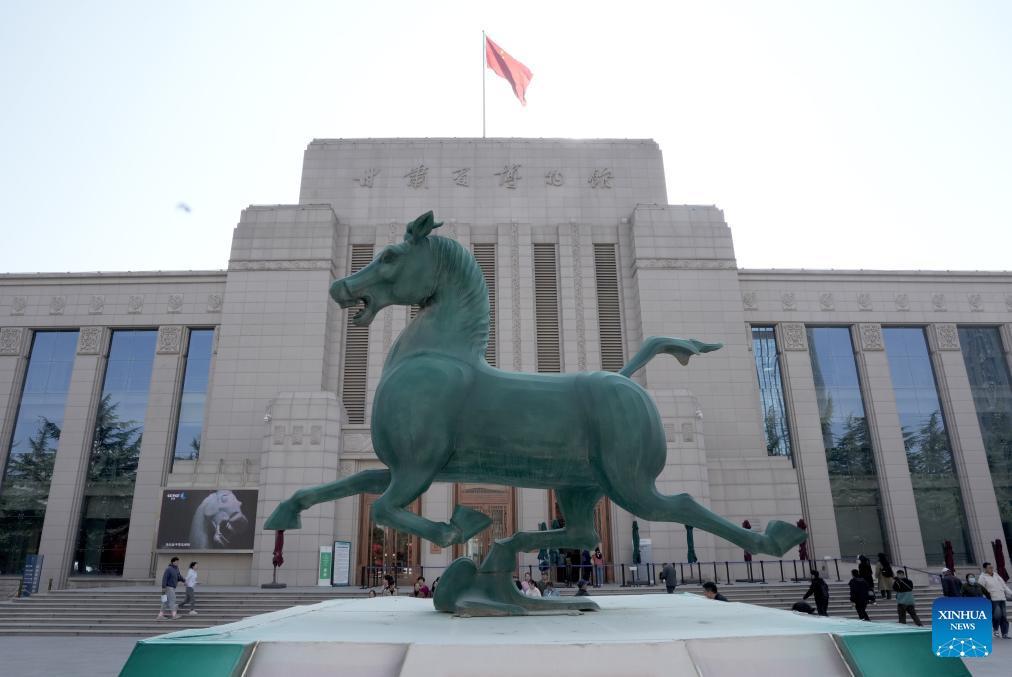
 0 Comment(s)
0 Comment(s) Print
Print E-mail China Daily, December 13, 2024
E-mail China Daily, December 13, 2024

This photo taken on Oct. 27, 2023 shows an enlarged replica of an ancient bronze horse statue in front of Gansu Provincial Museum in Lanzhou, capital of northwest China's Gansu Province. The bronze horse statue, popularly known as "Bronze Galloping Horse Treading on a Flying Swallow," was unearthed in 1960s from the Leitai Tomb of the Eastern Han Dynasty (25-220 AD) in Wuwei of Gansu and is now preserved in the Gansu Provincial Museum. Its image became a symbol of Chinese tourism in 1983. (Xinhua/Wang Yuguo)
Baby cabbage, broccoli and meatballs are placed in a pot while a shop staff member asks how spicy you'd like the dish. Though in a setting resembling a restaurant, these "ingredients" are actually plush toys designed by the Gansu Provincial Museum.
The museum introduced a series of food-inspired plush toys influenced by the growing popularity of local spicy hot pots. These lively representations of spicy hot pot ingredients have become a hit among visitors.
China's rich culinary heritage continues to inspire creative cultural products. With various expressions on their fluffy faces, plush toys based on local food traditions have gained nationwide popularity recently. People traveling to different regions not only indulge in local cuisines but also seek out plush toys representing these specialties.
A cultural product shop in Shaanxi province has introduced a plush version of the Chinese hamburger, or roujiamo, with meat sandwiched in a steamed bun. When a consumer purchases the toy, the packaging process mimics the real-life assembly of the burger — from selecting the bun and pouring sauce to adding the meat.
Videos of the packaging process for these food toys have garnered millions of views online, with comments like "so cute" and "full of emotional value". Some people even described the toy-purchasing experience as an adult version of playing house.
"The short interaction could immerse buyers in the experience. We are not just selling products, we are also selling culture and creating connections," Zhang Bo, co-founder of the Da Xiang Culture and Tech Company, the company behind the burger toy, was quoted by Guangming Daily newspaper as saying.
In Suzhou, Jiangsu province, consumers have lined up to buy plush toys inspired by the region's famous hairy crabs. Similarly, Changsha in Hunan province offers plush toys shaped like its iconic stinky tofu, while Tianjin has plush toys of Chinese crepes or jianbing.
Just as foodies have their own cuisine guide, toy fans are mapping out food toys across China on social media. Some even asked local gift shops to create plush toys of their favorite local dishes.
This growing trend aligns with the emerging "cute economy", which is especially popular among younger generations. A trending hashtag online reads, "Chinese have our own Jellycat," referring to the famous British toy brand known for its wide range of food-based plush toys.
In addition to food-themed toys, many museums in China have embraced the concept of transforming historical artifacts into plush toys, receiving positive responses from consumers.
The Hubei Provincial Museum offers a plush toy based on the Sword of Goujian, a key artifact from the Spring and Autumn Period (770-476 BC). As the centerpiece of the museum's collection, the sword toy was one of the museum's top three best-selling products last year. People nicknamed it the "little chubby sword."
When centuries-old artifacts are redesigned as soft, cuddly toys, the contrast fascinates consumers. With their fluffy texture and adorable faces, these plush toys have become popular cultural products.
Whether representing regional cuisine or historical artifacts, these plush toys serve as tangible expressions of culture. "Traditional culture doesn't have to exist in the past," said Xu Zhe, a staff member from the cultural and creative department of the Suzhou Museum, in an interview with Guangming Daily. "It can connect with different generations and create new meanings through design."
Xu believes that cultural products, combined with contemporary trends and aesthetics, can convey traditional values in a way that resonates with the younger generation.
Go to Forum >>0 Comment(s)